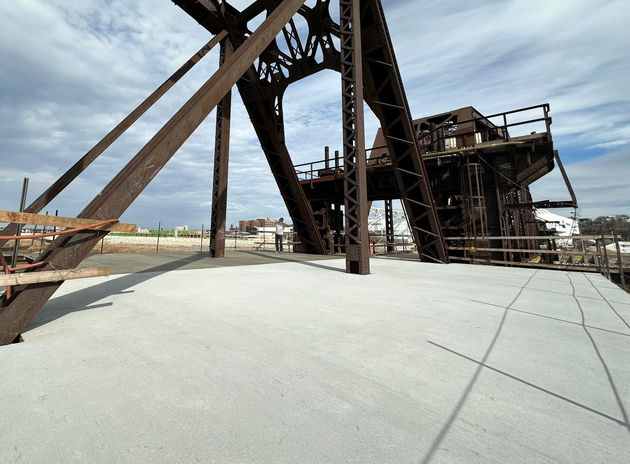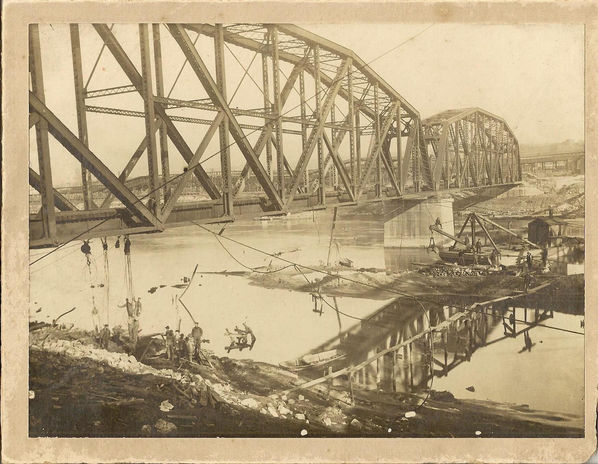
THE HIGHLINE LOWDOWN
Mike Zeller on how a 5-Foot Potato Gun Led to the Rock Island Bridge
Brett: What's it been like to do something like this? Transformational projects are hard because they’re different, generally. How long have you been at this?
Mike: Six years.
Brett: What gave you the crazy idea?
Mike: Well, I was on a boat holding a potato gun.
Brett: I mean, so many great stories start that way.
Mike: A friend had brought a boat up from Columbia. I had my three sons with me and we put it in the river. My oldest boy and I had built a potato cannon. It was like five feet tall. I still have it. We were going up and down the Missouri River just checking it out, which is really cool if you haven’t seen your city by water. The bridges are huge. It’s dramatic.
I said, “Let’s go up the Kansas River.” I didn’t know anything about it., but as we went south and came into the open, we were all looking at this thing and probably thinking the same thing: “What the **** is that?” As we got closer, we realized it’s not a car bridge. It’s a railroad bridge, and it was unused. To my untrained eye, it looked pretty robust. I mean, it’s built to carry freight trains. I said, “Somebody ought to do something with that. Put a restaurant out there and call it Chicken on a Bridge.”
Brett: Is this before Chicken N Pickle?
Mike: Yeah. It was 2008.
Kathryn: So how has the process been?
Mike: It’s been hard because even though my life seems to have prepared me for this, the fact that I'm not a developer slowed it down. That said, I have undertaken a few entrepreneurial endeavors, and job at KC Public Television (KCPT) as Development Director helped. Through KCPT, I met a lot of Kansas City - I learned how to frame ideas and allow other people to take collective ownership of what’s happening.
Kathryn: Elaborate on that a little.
Mike: Well, for the first several years working and pitching this throughout Kansas City Kansas, I was known as the crazy bridge guy. Which was a badge I wore with honor. I knew I wasn’t crazy, but I did often have to stop and question if I was drinking my own Kool-Aid. I would ask people that. “Tell me; is this crazy?”
Brett: Everybody probably did tell you that you were crazy. If there are times when you got enough feedback that you were crazy, why did you continue to do it?
Mike: Because I always thought it was a commonsense idea, if the numbers would pencil, it would work. And the numbers do pencil because we don’t have to build the bridge. It’s here, and our reward for pulling together a very complicated public/private/philanthropic partnership, that not only converts blight into value and redefines an area, is that it rebrands and starts a transformation of a 19th Century Industrial River into a 21st Century recreational waterway in the heart of a major metro.
Kathryn: Are you comfortable operating and collaborating in more of an amorphous way?
Mike: I think if you hold your open arms out, people give you great ideas. This is not my idea. Chicken on a Bridge was my idea. This was maybe 100 people’s idea.
Brett: Yeah. Is that a signature trait of somebody trying something transformational? Ambiguity?
Mike: But I didn’t start out to drive transformation. I started out to prove an unproven model that a bridge could be treated like land and commercialized.
Brett: What was it like getting investors on board?
Mike: I think with validation, you’ve got to create this flywheel that feels like this thing is inevitable. I had to demonstrate to a lot of people through my actions that I wasn’t going to give up. That was important because nobody wants to bet on somebody who they think is going to give up. I think when I hung in there, they figured out that I was relentless.
Brett: When do you open? Or should I ask, when is the first plate of chicken served?
Mike: June of next year.
Brett: What does that look like? Is that the project done? Is that Phase One done?
Mike: It will evolve, no doubt. I'm always tinkering and figuring out how to add more shade here, plant some vines there, and masking "how can we have fun with this thing?" In years two, three, or four – after we catch our breath – and learn how the bridge responds, we can continue with our concept of "creating land" over water. We can put land on top of one or more of these lift gates, we could add over there..."







